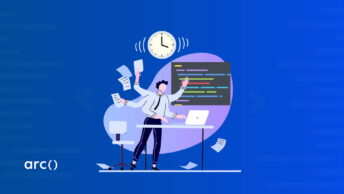Software developer jobs today require that you possess excellent problem-solving skills, and for good reason. Unfortunately, there seems to be a sort of talent gap when it comes to this one skill required of all software developers.
Troubleshooting and problem resolution are both informally and formally taught, but you mostly find that software developers have to learn problem-solving skills on their own. This is true for self-taught developers, obviously, but also even for those with software engineering degrees or who’ve graduated from coding boot camps.
This is why it’s necessary to acquaint yourself with the problem-solving process, whether you are a newbie or an experienced developer. In this article, we’ll explore everything you need to know about problem-solving so you can 10x your software development career.
What are Problem-Solving Skills?
As a developer, what do we mean by problem-solving? Let’s attempt a simple definition.
In software development, problem-solving is the process of using theories and research to find solutions to a problem domain, while testing different ideas and applying best practices to achieve a desired result. Problem-solving also has to do with utilizing creativity and logical thought processes to identify problems and resolve them with software.
Becoming a great software developer hinges more on learning algorithms than programming languages or frameworks. And algorithms are simply step-by-step instructions to solve a given problem.
Read More: How to Build a Software Engineer Portfolio (With Examples & Tips)
Why are impeccable problem-solving skills crucial?
Making good use of a computer language can be likened to being a skilled writer. An effective writer must know how to construct sentences and use grammar appropriately. There’s more to writing than just knowing all the words in the dictionary, and that’s how it works for developers, too.
You have different tasks to work on as a software developer, including perhaps designing, coding, and troubleshooting. Much of your time will be spent on identifying problems, spotting and correcting bugs, and making sense of codebases from before you started working there. Being ingenious at problem-solving is essential in creating incredible solutions to issues that arise throughout software development.
To demonstrate ingenuity, let’s consider Google’s autocomplete tool as an example.
The autocomplete tool is built to suggest related terms in the search bar as you type. The idea behind the tool is to reduce more than 200 years of time spent typing daily and to help users save time by up to 25% while typing.
Here’s what had to be done:
- To activate real-time completion of suggestions, the UI experience and JavaScript had to be implemented.
- Next, since users could type just about anything, the autocomplete suggestions had to be compiled into a sensible list dependent on user input.
- Then, Google had to create a back-end sustainability system for this function. Doing this meant massively increasing its infrastructure to accommodate all forms of data query and HTTP requests.
- Finally, the user interface had to be refined by software engineers in order to make sure that every user enjoyed a worthwhile experience. So they employed Google Trends to power the auto-completion tool while using algorithms to take out explicit or offensive predictions in line with Google’s auto-completion policy.
This is just one of Google’s innumerable problem-solving examples, but it’s clear to see that solving problems involves more than just telling a computer to do stuff. It’s about your ability to come up with parameters rightly tailored to target users so they can meet their goals.
So why must developers focus on problem-solving at work?
Software developers work with a wide range of people and departments, and it’s common to discover that some clients and teams find it difficult to define what they want. As a problem solver, it’s up to you to help them identify their needs and communicate their thoughts in an effective way.
Of course, you’ll need time and practice to develop your problem resolution ability. That’s because it’s less about solving problems faster but more about coming up with the best solution. And then you’ll need to deploy that solution.
Read More: Common Interview Questions for Software Developer Jobs (Non-Technical)
Types of problem-solving skills
Now let’s talk about four types of problem-solving skills for developers:
1. Parallel thinking
As a software developer, parallel thinking is a crucial skill necessary to perform optimally. This makes it possible for you to carry out two tasks that complement each other at the same time (like an optimized form of multitasking skills). Being able to reorder tasks to boost parallel execution can help to improve your output and save valuable time.
2. Dissecting broad and/or complex goals
When it comes to building software, you will need to effectively outline the steps and tasks necessary to achieve your goal. Developers must learn to break large and complex tasks into smaller assignments because this is an important skill that will help you create results with precision.
3. Reimplementing existing solutions
You don’t always need to reinvent the wheel. Part of being an effective software developer comes with being able to use already existing tools before even thinking of creating new solutions. Developing problem-solving skills is very much connected to finding solutions that already exist and reusing them.
4. Abstraction
Keep in mind that goals tend to evolve. So if your client comes up with new ideas, that will mean changing your design goals and reordering your tasks. A good programmer must learn to create solutions in such a way that does not require a complete redesign from scratch.
You also have to become adept at abstracting problems so that your solutions can get them resolved so long as they aren’t entirely different from the original issue. You don’t necessarily have to abstract every aspect to avoid more complications being created. This calls for balance by abstracting only where necessary without making narrow decisions.
Read More: Learn 8 Great Benefits of Working From Home
4 Important Tips & Strategies for Improving Problem-Solving Skills
To keep your problem-solving skills and techniques from growing weaker over time, you need to exercise them non-stop. As they say: practice makes perfect!
To train the problem-solving side of your brain, these four tips and strategies can help you improve your abilities:
1. Make problem-solving a part of your life
Never restrict yourself to working on problems only during work hours. Don’t make it a chore, but, instead, do things that make problem-solving look fun. The game of chess, solving puzzles, and playing video games that compel you to think critically will help strengthen your problem-solving skills, and you can tell your significant other you are advancing your career! 🙂
When you come to a complex problem in your life, whether it’s budgeting for a home or renovating the downstairs bathroom, approach it both creatively and critically. Ask yourself: What would a great software engineer do in this situation?
2. Use different platforms to solve problems
Proffer solutions to a set of problems without restricting yourself to one platform. Using different platforms and tools regularly helps make sure you become flexible as a problem-solver. And it makes sense, because there really is no universal solution for the different problems that pop up in your line of work. Trying out different platforms to solve different problems helps you to keep an open mind and enables you to test out different techniques when looking to find solutions.
Read More: 12 Common Mistakes Keeping You From Landing Your First Developer Job
3. Be open to assistance from external sources
Part of being a good software developer comes with being able to ask for help and also accept all forms of feedback. You might need a different opinion or a new set of eyes to help find the most fitting solution to some problems. It makes sense to view building problem-solving skills as more of a team effort rather than a personal journey.
Have an open mind and heart to function not only as an individual but also as a collective. It’s a utopian working environment where everyone supports each other to become better versions of themselves. So if you come across an issue that keeps you stuck, get help! You may find someone who has a more refined framework or method you never knew existed or would have thought of using. You could then learn from them and add their solution to your toolkit.
Get feedback often, as well. This could be the catalyst to making improvements to your processes and evolving them into something truly refined.
4. Tackle new problems using lessons from past solutions
As you practice and finesse your ability to identify problems and find solutions, you’ll begin to notice patterns. It’s more like developing your toolbox armed with a wide range of solutions that have proved useful in the past. So when problems emerge, you will notice how easy it is to take some of those old solutions and apply them to the new problem.
The more you attempt to apply creativity in solving problems, the more you grow your skills. In the long run, that will help you find the right solutions faster and apply them to a wide range of problems more naturally. It’s all about improving the effectiveness and efficiency with which you tackle new problems while applying only the best possible solutions.
Read More: How to Stay Motivated at Work
3 Complementary Skills to Improve to Become a Good Problem Solver
Developing software is mostly about problem-solving at the very core before even writing your first lines of code. You have to identify problems that can be solved using software. Then you have to go on to understand how people try to solve such problems in real life.
It’s up to you to come up with a framework that allows you to take both the problem and the solution and convert them into computer code. And you have to do this in such a way that makes the software even more efficient and effective than a human.
While going through this process, developers also have to handle other problems such as deadline deliveries, checking for bugs and fixing them, and collaborate across teams. So, supporting skills must not be overlooked.
Teamwork
Software developers must build interpersonal skills and collaboration skills. Being able to empathize, accept feedback, handle criticism, listen intently, and show respect for others are all important characteristics and abilities necessary for teamwork, and, thus, necessary for solving problems on the job.
Read More: 5 Ways to Stand Out & Get Noticed in Your Current Development Job
Communication
No one is an island, and that’s true when you consider how software engineers work. Building software requires keeping up with clients and teammates and other departments. You can’t afford to be a Lone Ranger, at least not 100% of the time, and that’s why employers always look for good communication skills.
Being a good software developer also involves how well you can break down very complex concepts to laypeople. You want to be the kind of person who fixes a problem and is able to explain how you were able to do it. It’s all about your ability to be clear and articulate about every aspect of your work. And you want to be able to communicate not just verbally but also in written form.
To build your communication skills as a developer, you can learn from more experienced people and observe how they interact with their clients. And, don’t forget, with more and more companies becoming global enterprises and going remote, it’s important to brush up on your intercultural communication skills, as well.
Logical thinking
The difference between elite software developers and average ones is often said to be logical thinking. The ability to process thoughts logically is important, because you’ll often spend most of your time finding and fixing bugs rather than writing code.
Problems can show up from just about anywhere, even from what seems to be the most insignificant errors. So, your ability to detect software issues and solve these problems using deductive thought processes is a vital ingredient to your success as a software developer.
Read More: Questions to Ask at Interviews for Software Engineering Jobs
Problem-Solving Stages & Practices
There are countless problem-solving processes and various schools of thought regarding the best way to approach problems whenever they arise. To solve that problem, we’ve pooled some of these frameworks together to come up with a comprehensive approach to problem-solving.
Step 1 – Define the problem
You have to first start with problem identification. Knowing what you are dealing with is important, because you don’t want to risk spending valuable time applying wrong solutions. Avoid making automatic assumptions. Even when the symptoms look familiar, you want to investigate properly because such signs could be pointing to something else entirely.
Problems in software development come in different sizes and scopes. You could be having trouble getting some aspects of the product to respond in the desired way. Or maybe you’re having issues trying to decipher a codebase section where you can no longer communicate with the original developers. Sometimes, the problem could come in the form of an unfamiliar error message and you’re at loss.
Once you’re able to define the problem, make sure to document it.
Step 2 – Analyze the problem
Now it’s time to carry out problem analysis. Before deciding what problem resolution methods to adopt, it’s necessary to find out all there is to the issue, which builds on our first step. This will make it easier to come up with ideas and solutions later on.
Problem analysis isn’t always a walk in the park. There are times when the problem involves a very small mistake such as failing to import a package correctly or a small syntax error. Other times, however, it could be such a huge error, like the entire program acting differently than what you want. There might be no alarms or blinking red lights to tell you what the exact problem is.
If you encounter such situations, you can find answers by articulating the problem. Document what you intend to do, what you’ve done, the original intention for the program, and where you currently are. Communication comes in handy here, of course, not just in your documentation, but also in how you relay it to your teammates.
Read More: Got a Busy Developer Schedule? Here’s How to Keep Learning & Make Time
Step 3 – Brainstorm
This step has to do with generating ideas, and you can benefit from discussing the problem with a team and then coming up with ways to get it fixed. Keep in mind that problem-solving at work involves interacting with a diverse group of people where the individuals have unique skill sets and experiences.
Many developers tend to neglect the previous steps and rush straight into brainstorming. That’s definitely not a good way to go about problem-solving. The idea is not to skip the important steps in the process.
Once you get to the point where ideas need to be generated, do not discard any, because this step relies on a wide range of ideas. Only after gathering as many perspectives as possible should you then begin reviewing and narrowing down to the best possible solution.
Step 4 – Make a decision
At this point, all viable solutions have to be analyzed before selecting the most appropriate one to implement. Picking the best possible solution depends on its ability to meet certain criteria. It must be suitable, feasible, and then acceptable.
What it means is that the solution must be able to get the problem solved. It should also be easy to see how such a solution fits into the equation. And then every member of the team involved in the brainstorming process has to unanimously accept the solution.
Read More: How to Network as a Software Engineer
Step 5 – Implement
After identifying and choosing the solution, the next logical step is to plan out the implementation process and then execute it. Coming up with a detailed plan is crucial if the solution is to be a success.
Now this plan must detail all the necessary steps required to implement the solution. It will also explain the length of time and stages of work required. Once all of that is put in place, you can then move forward with the execution. The idea is not just to execute a solution but to do it the right way.
Implementation using automated tests can help to keep unexpected issues from arising in the future. Some other problem-solving practices or approaches begin the process with this step. So, whenever any changes are made to the project, tests asserting that the changes will perform as required will be written first before the changes are then made.
Step 6 – Evaluate
No problem-solving process can be deemed comprehensive enough if there is no room for evaluation. Whatever the solution may be, it has to undergo strict evaluation in order to see how it performs. That will also help determine whether the problem still exists and the extent to which such an issue keeps recurring.
In the event that the problem persists despite the implementation of a detailed plan, then the developer and team may even have to restart the problem-solving process. However discouraging that may sound, at least you’ll have caught it early enough. And, this also proves the process worked.
Read More: How to Become a Software Engineer: Education, Steps & Tips for Success
Final Thoughts
Developing problem-solving skills is quite necessary for software developers. To be a successful problem solver, you will need lots of years down the line to practice what you study.
Always remember that you are a problem solver first before anything else. There is more to building software than just understanding the tech behind it and writing lines of code. It’s all about improving your ability to identify problems and find solutions, and that will need lots of experience on your part.
Never shy away from problems, but learn to think critically and logically in any situation. By applying the six-step strategy for problem-solving at work discussed in this piece, you will be more equipped to come up with the most effective and efficient solutions.
We hope you enjoyed reading our guide on how to solve a problem as a software developer and ways to improve skills as a problem solver! If you have any questions, feedback, or other great problem-solving techniques or methods, let us know in the comments below 🙂











